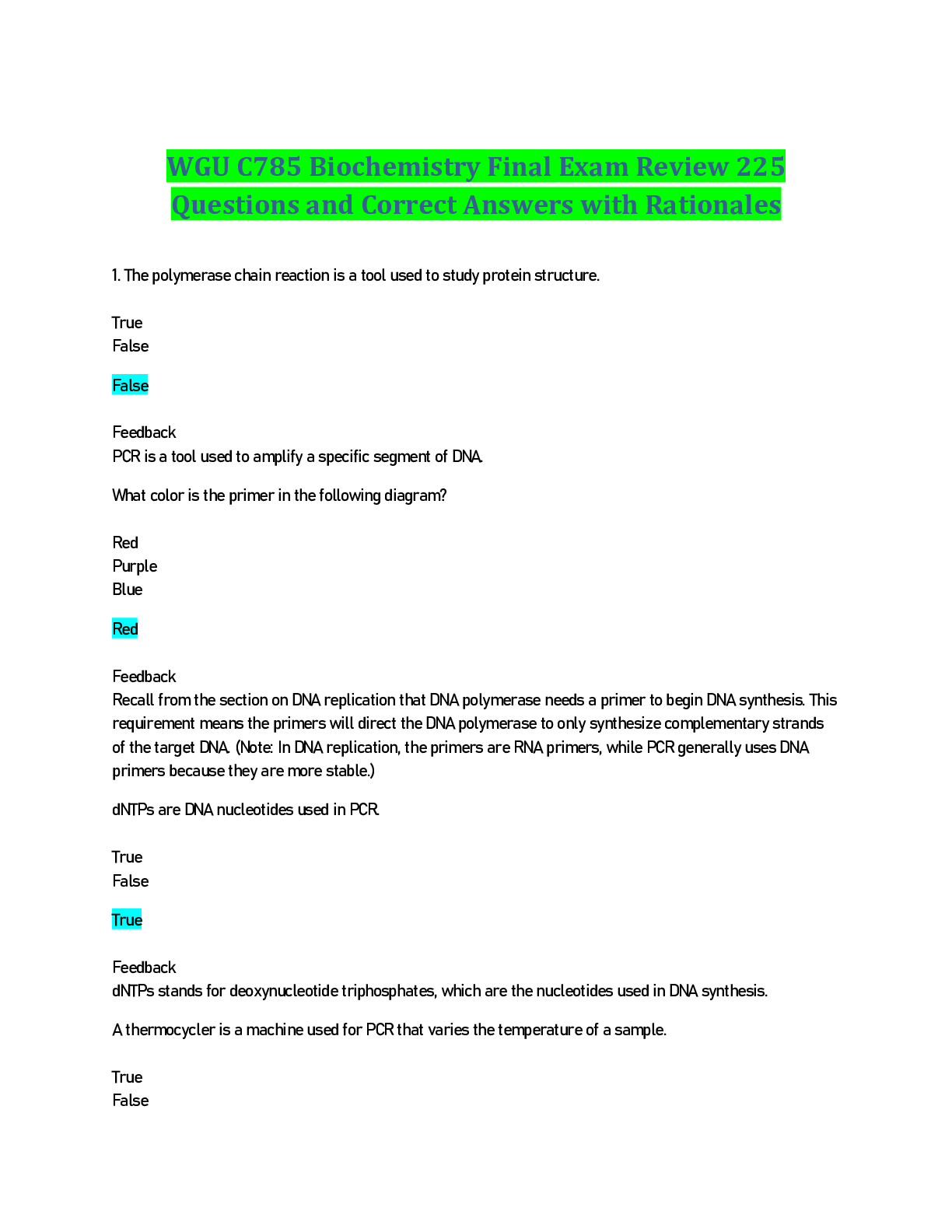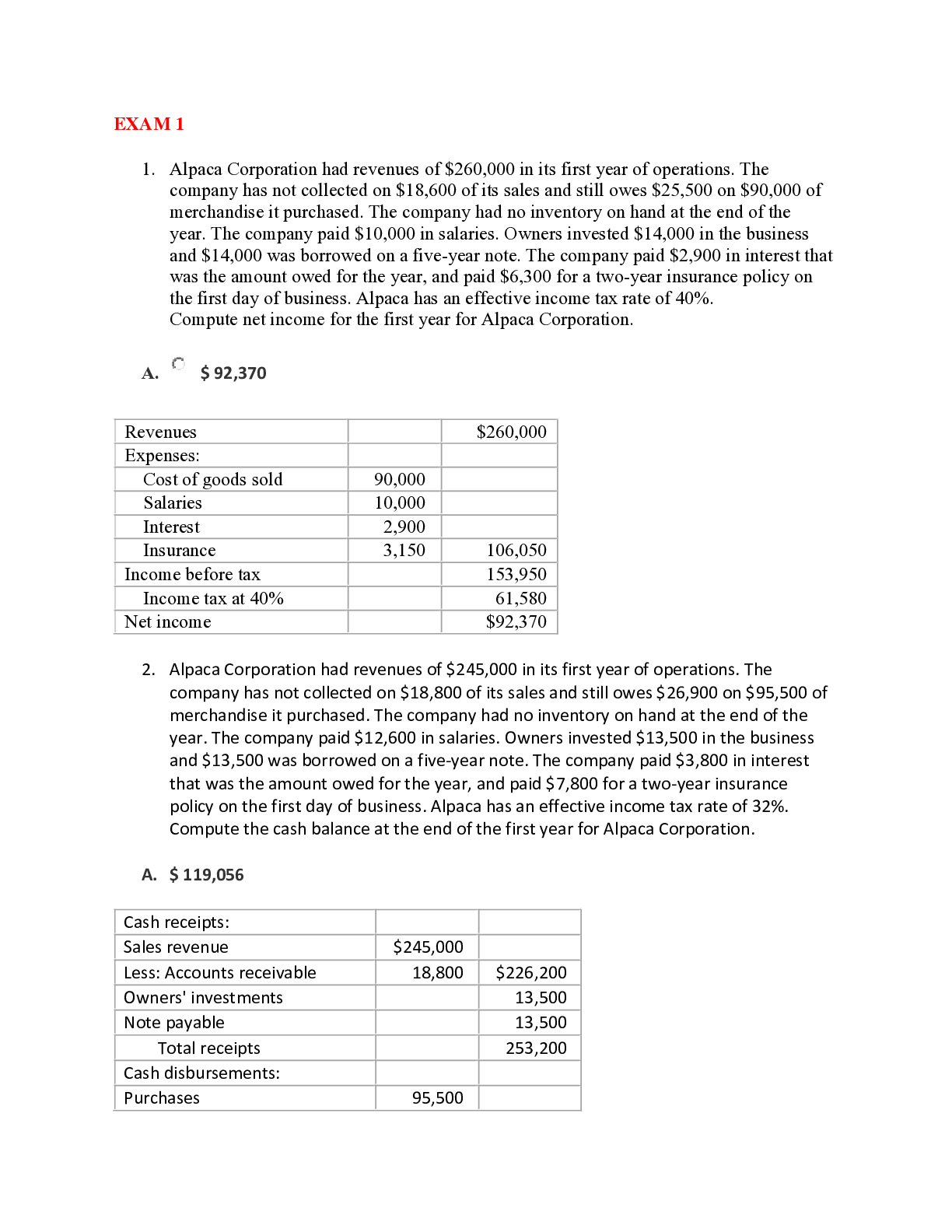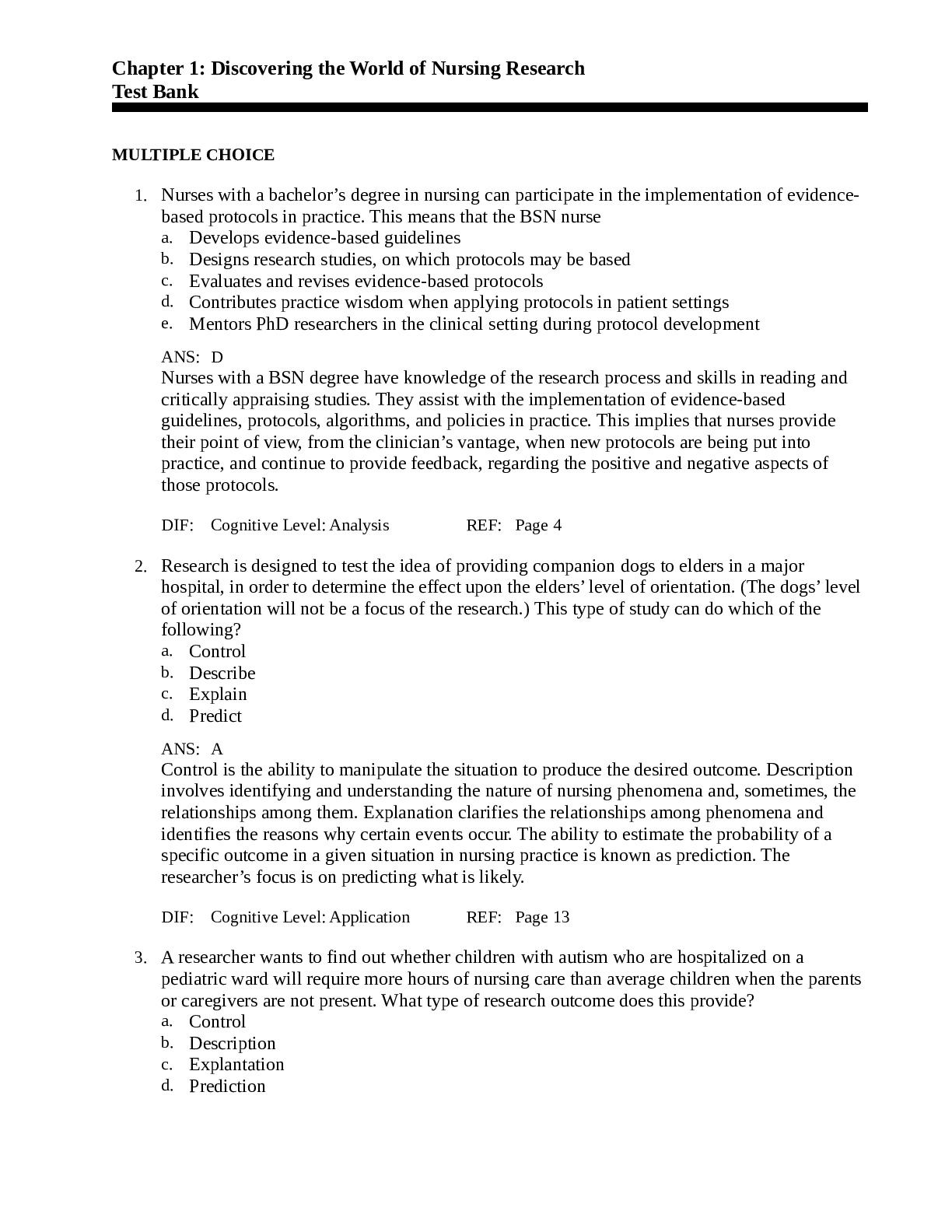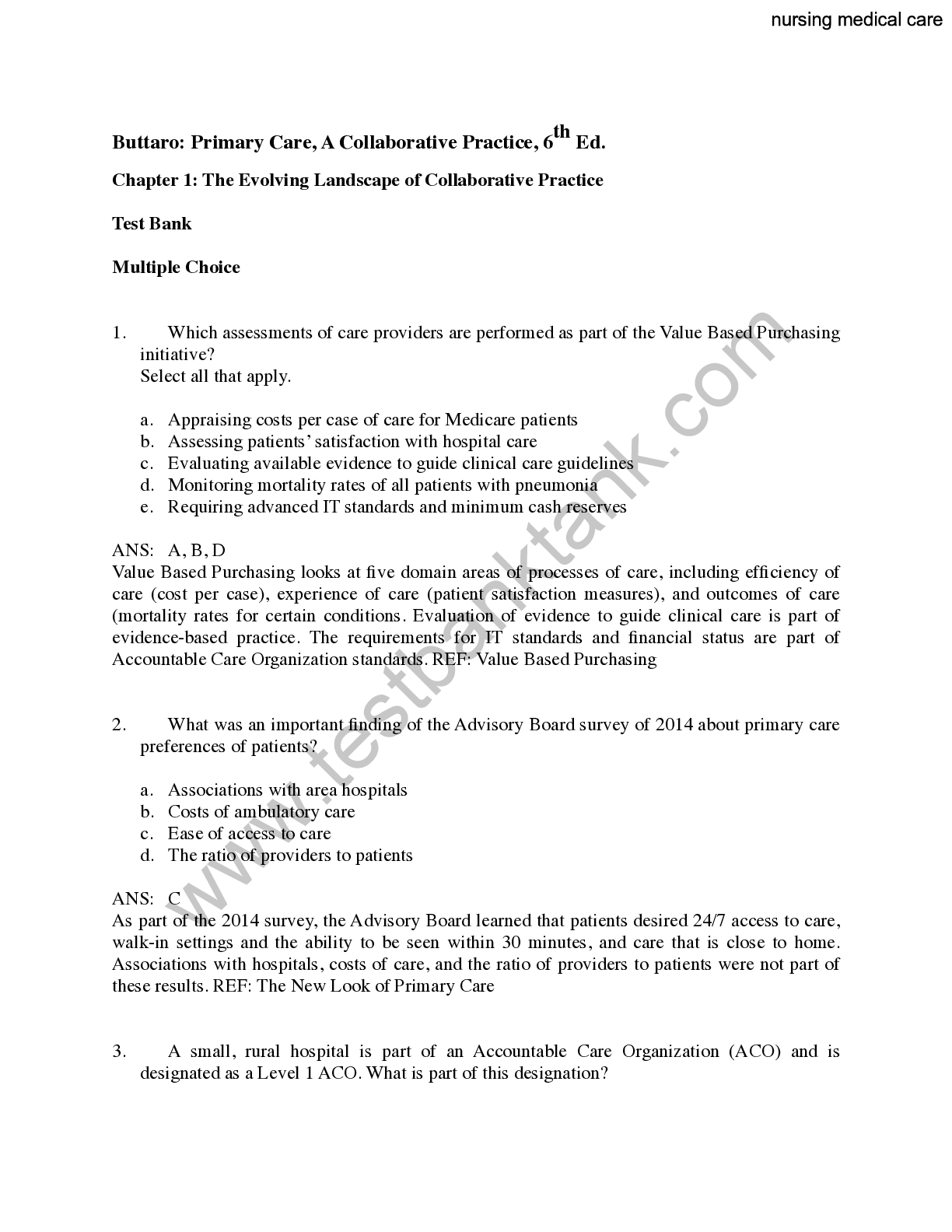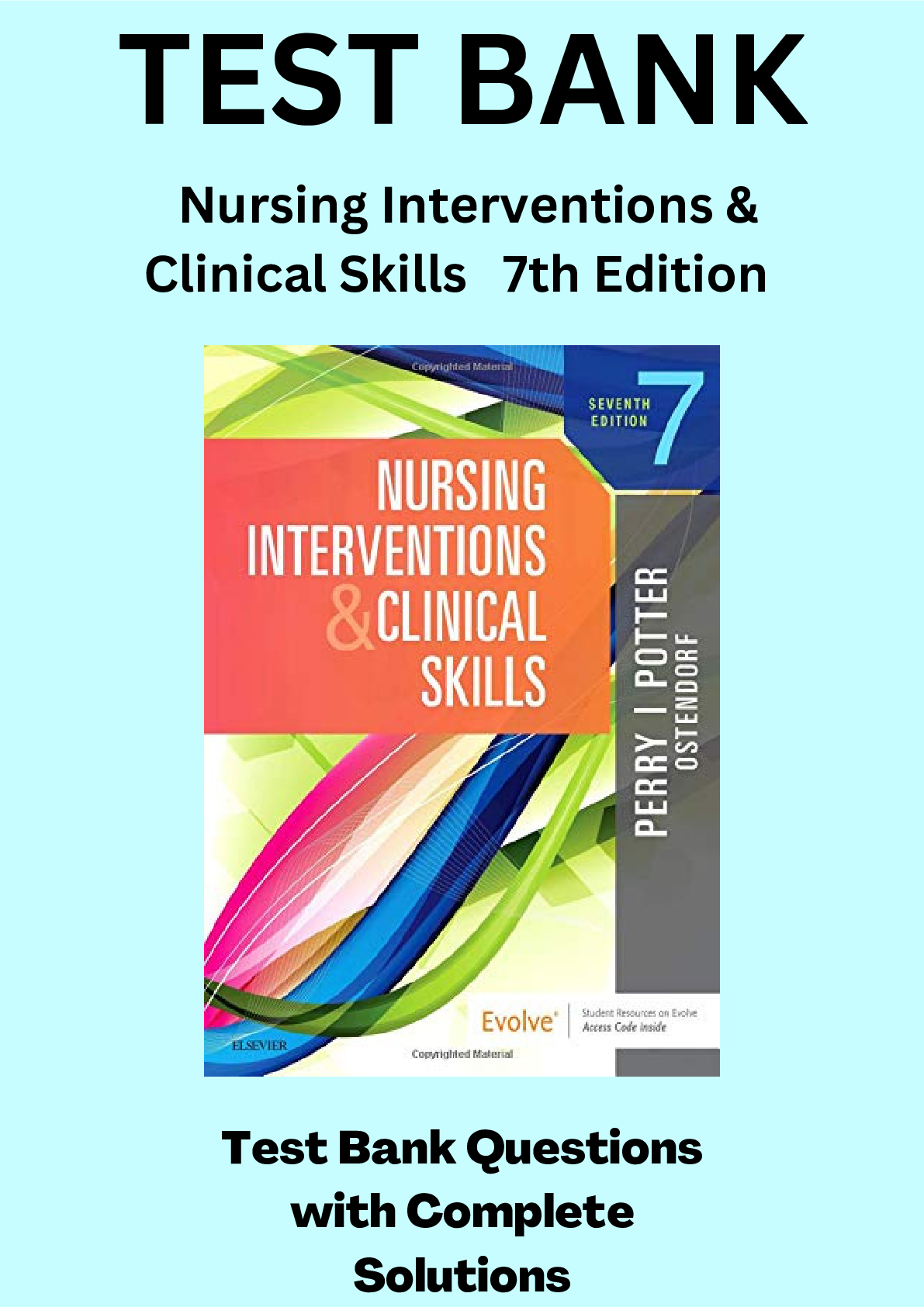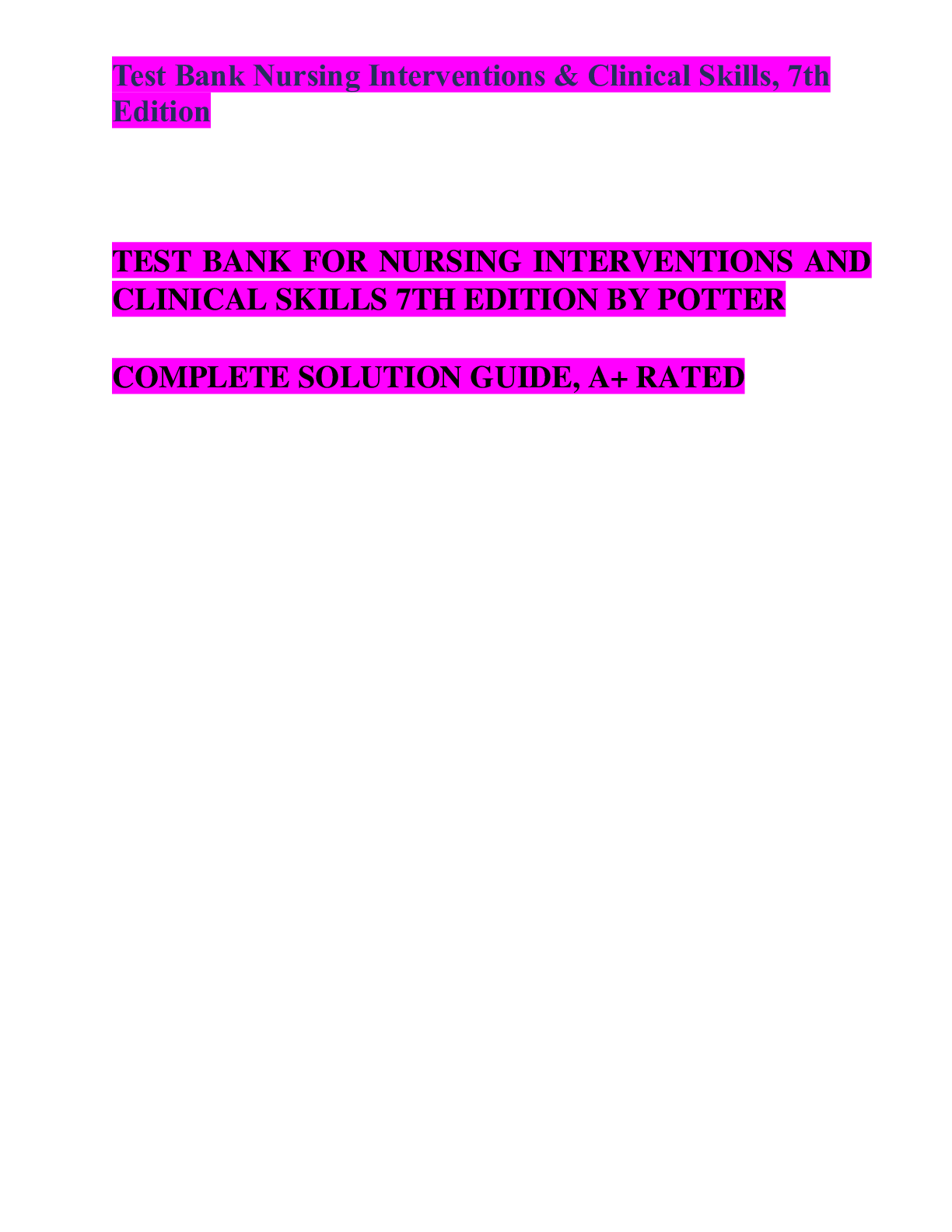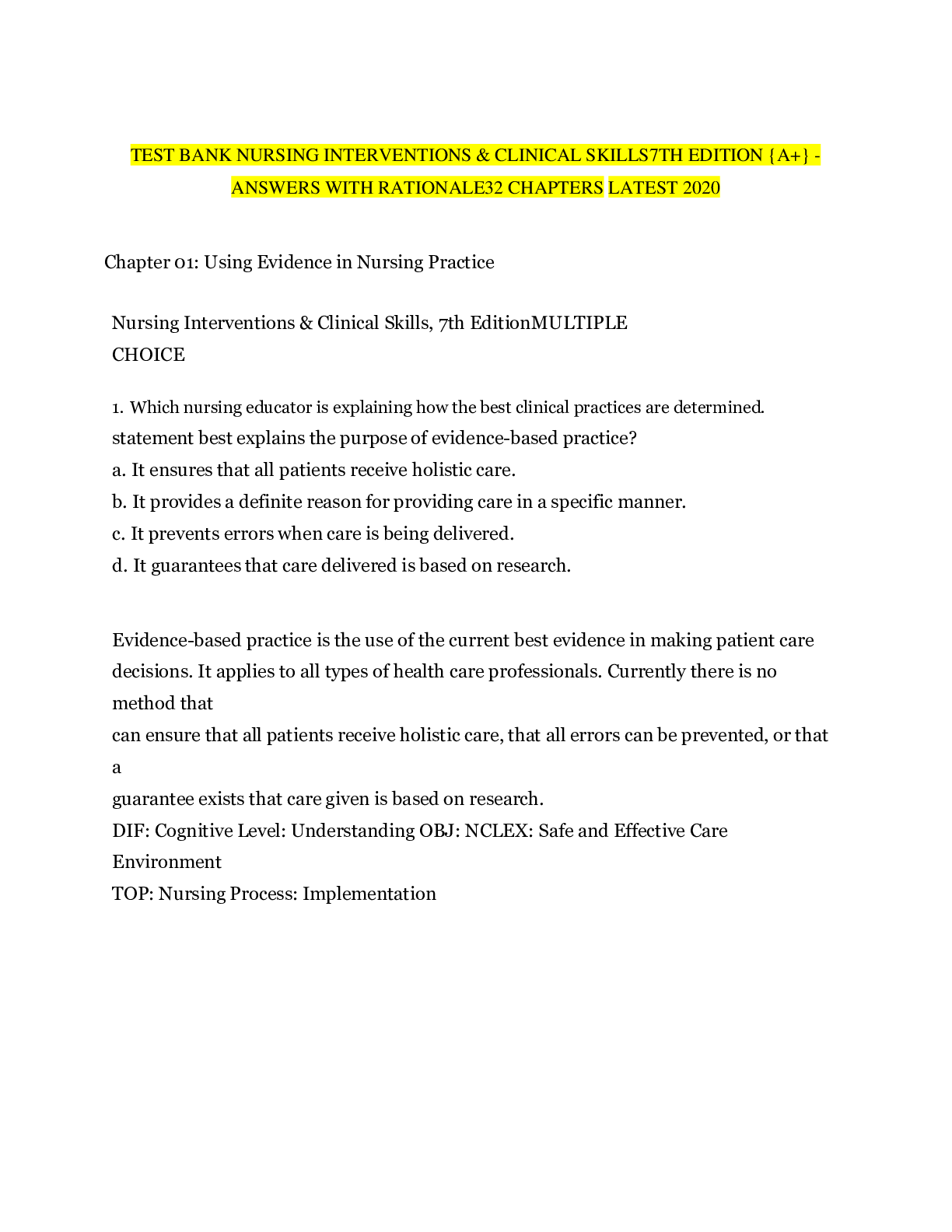*NURSING > TEST BANK > TEST BANK Nursing Interventions & Clinical Skills 7th Edition {A+} - Answers with rationale | 32 CHA (All)
TEST BANK Nursing Interventions & Clinical Skills 7th Edition {A+} - Answers with rationale | 32 CHAPTERS
Document Content and Description Below
Chapter 01: Using Evidence in Nursing Practice Perry et al.: Nursing Interventions & Clinical Skills, 7th Edition MULTIPLE CHOICE 1. A nursing educator is explaining how the best clinical practices... are determined. Which statement best explains the purpose of evidence-based practice? a. It ensures that all patients receive holistic care. b. It provides a definite reason for providing care in a specific manner. c. It prevents errors when care is being delivered. d. It guarantees that care delivered is based on research. ANS: B Evidence-based practice is the use of the current best evidence in making patient care decisions. It applies to all types of health care professionals. Currently there is no method that can ensure that all patients receive holistic care, that all errors can be prevented, or that a guarantee exists that care given is based on research. DIF: Cognitive Level: Understanding OBJ: NCLEX: Safe and Effective Care Environment TOP: Nursing Process: Implementation 2. Which question is a problem-focused trigger for initiating the evidence-based practice method in nursing care? a. What is known about reduction of urinary tract infections in the older adult with diabetes? b. How can chronic pain best be described when the patient is nonverbal? c. How long can an IV catheter remain in place in a patient with obesity? d. What measures can the nurse take to reduce the rising incidence of urinary tract infections on the older adult care unit? ANS: D Evidence-based practice (EBP) questions tend to arise from two sources: recurrent problems or new knowledge. In the correct option, the increase in urinary tract infections indicates a trend or recurring problem in a specific group of patients. The other questions are general information questions, not based on what is happening in a specific area or to a group of specific patients in an area or relating to an observed trend. DIF: Cognitive Level: Applying OBJ: NCLEX: Safe and Effective Care Environment TOP: Nursing Process: Implementation 3. What does the “I” indicate in a “PICO” question? a. Intervention of interest b. Incorporation of concepts c. Implementation by nursing d. Interest of personnel ANS: A The “I” stands for intervention of interest, meaning what the nurse hopes to use in practice and believes is worthwhile or valuable. This could be a treatment for a specific type of wound or an approach on how to teach food preparation for a patient with impaired sight. TEST BANK FOR NURSING INTERVENTIONS AND CLINICAL SKILLS 7TH EDITION BY POTTER TESTBANKWORLD.ORGN DIF: Cognitive Level: Remembering OBJ: NCLEX: Safe and Effective Care Environment TOP: Nursing Process: Implementation 4. Who will the clinical research nurse contact to search relevant databases in preparation for an upcoming study? a. The physician whose patients may be involved in the study b. The medical librarian c. The nurse manager of the unit where the study will be conducted d. The director of nursing of the facility ANS: B The medical librarian is most knowledgeable regarding databases relevant to a study. The other individuals do not have the knowledge regarding relevant databases. DIF: Cognitive Level: Understanding OBJ: NCLEX: Safe and Effective Care Environment TOP: Nursing Process: Implementation 5. Which database contains summaries of clinical guidelines and their development? a. MEDLINE b. CINAHL c. Cochrane Database of Systematic Reviews d. The National Guideline Clearinghouse ANS: D The National Guideline Clearinghouse is a database supported by the Agency for Healthcare Research and Quality. It contains summaries of clinical guidelines for practice. MEDLINE is a database for studies in medicine, nursing, dentistry, psychiatry, veterinary medicine, and allied health. CINAHL (Cumulative Index of Nursing and Allied Health Literature) includes studies in nursing, allied health, and biomedicine. The Cochrane Database Full text of regularly updated systematic reviews prepared by the Cochrane Collaboration includes completed reviews and protocols. DIF: Cognitive Level: Remembering OBJ: NCLEX: Safe and Effective Care Environment TOP: Nursing Process: Implementation 6. Which does the nurse researcher identify as the strongest type of research? a. Randomized controlled trials b. A qualitative study c. A descriptive study d. A case controlled study ANS: A Individual randomized controlled trials are close to the top of the research pyramid. Only systematic reviews and meta-analyses are higher. This type of study tests an intervention against the usual standard of care. The other types of studies are useful but do not give the same type of information as a randomized controlled trial provides. DIF: Cognitive Level: Remembering OBJ: NCLEX: Safe and Effective Care Environment TOP: Nursing Process: Assessment TEST BANK FOR NURSING INTERVENTIONS AND CLINICAL SKILLS 7TH EDITION BY POTTER TESTBANKWORLD.ORGN 7. What is the nurse attempting to determine when critiquing the evidence related to a PICOT question? a. The ethical conduct of the research the nurse read b. The strength of the evidence found in the literature c. If there are any experts in the clinical question needing to be researched d. If the study demonstrates cost-effectiveness if a change in practice occurs ANS: B Once a literature search is complete and data are gathered about the question, it is time to critique the evidence. Critiquing the evidence involves a systematic approach to looking at the strength of the work reviewed and its relevance. The other questions are not applicable to critiquing the evidence. DIF: Cognitive Level: Understanding OBJ: NCLEX: Safe and Effective Care Environment TOP: Nursing Process: Implementation 8. A nurse finds a cohort study comparing one group taking hormone treatment with another group not taking hormone treatment to determine the incidence of changes in bone density of the lower spine. What can the nurse imply from this study? a. Low level of strength makes the study limited in value. b. Moderate level of strength makes the study probably useful. c. Opinions of the individuals in the cohort are not research. d. This could be the basis for a Quality Improvement project. ANS: B A cohort study is Level 4 evidence as it is a single, non-experimental study. This moderate level of evidence makes the study probably useful but the nurse should strive to find stronger evidence. DIF: Cognitive Level: Applying OBJ: NCLEX: Safe and Effective Care Environment TOP: Nursing Process: Evaluation 9. Which question would be the best example of a knowledge-focused trigger for conducting an evidence-based practice project? a. What is the best method for treatment of leg swelling when a patient is taking gabapentin (Neurontin)? b. How can we decrease the incidence of skin cancer in adults over the age of 65? c. What is the current evidence for improving oral intake for cancer patients with stomatitis? d. What is the maximal length of time our hospital allows irrigation kits to be used? ANS: C Evidence-based practice (EBP) questions tend to arise from two sources: recurrent problems or new knowledge. In this example, the new knowledge that drives the question is the one looking at current evidence. The other questions do not look at the newest knowledge to form a question to research. DIF: Cognitive Level: Analyzing OBJ: NCLEX: Safe and Effective Care Environment TOP: Nursing Process: Implementation MULTIPLE RESPONSE TEST BANK FOR NURSING INTERVENTIONS AND CLINICAL SKILLS 7TH EDITION BY POTTER TESTBANKWORLD.ORGN 1. When planning to implement an evidence-based practice strategy, what factors are most important for the nurse to consider and include? (Select all that apply.) a. Time required to perform the strategy b. Patient preferences and values c. Clinical expertise d. Scientific knowledge e. Historical practices ANS: B, C, D When implementing evidence-based practice, the nurse considers and includes clinical expertise and patient preferences and values in addition to the scientific knowledge. Time required to perform the new strategy and customary practices are not vital to this approach. In fact, EBP seeks to ensure practices are based on evidence and not just historical practice. DIF: Cognitive Level: Remembering OBJ: NCLEX: Safe and Effective Care Environment TOP: Nursing Process: Implementation 2. A new nurse wants to ensure practice is based on the best knowledge available. What actions are best for this nurse to be involved in evidence-based practice? (Select all that apply.) a. Design and conduct a study based on interest. b. Join the hospital’s policy review committee. c. Remain vigilant for recurring problems. d. Maintain a spirit of inquiry. e. Read current literature appropriate to practice area. ANS: B, C, D, E This novice nurse would best maintain an evidence-based nursing practice by joining policy review committees, watching for and taking note of recurring problems in the practice area, maintaining a spirit of inquiry, and staying current in the literature. The nurse would not need to design and conduct a study. DIF: Cognitive Level: Applying OBJ: NCLEX: Safe and Effective Care Environment TOP: Nursing Process: Implementation 3. When explaining the value of evidence-based practice, what benefits does the nurse include? (Select all that apply.) a. Improves quality of care. b. Improves patient outcomes. c. Improves stakeholder satisfaction. d. Incorporates near real-time data in practice. e. Helps nurses remain current in practice. ANS: A, B, D, E There are five ways that EBP adds value to the health care system: helps clinicians remain current on standardized, evidence-based protocols; uses near real-time scientific data to make care decisions; improves transparency, accountability, and value (e.g. safe care); improves quality of care; and improves outcomes. One would hope all stakeholders would be more satisfied with this method of determining care but that is not one of the specific benefits. DIF: Cognitive Level: Remembering OBJ: NCLEX: Safe and Effective Care Environment TOP: Nursing Process: Implementation TEST BANK FOR NURSING INTERVENTIONS AND CLINICAL SKILLS 7TH EDITION BY POTTER TESTBANKWORLD.ORGN Chapter 02: Communication and Collaboration Perry et al.: Nursing Interventions & Clinical Skills, 7th Edition MULTIPLE CHOICE 1. The nurse interviews a patient during admission. Which observation by the nurse identifies consistency between the patient’s verbal and nonverbal communication? a. Asserts she is eager to answer questions while reading a magazine. b. States that he wants information while frequently changing the subject. c. Asks the nurse to explain a surgical procedure while she listens intently. d. Explains that he is relaxed while continuously shifting in his chair. ANS: C The patient demonstrates congruency, or consistency, between her verbal statement asking for an explanation and her nonverbal cue of listening intently. The verbal and nonverbal messages match; each indicates that the nurse’s response is important to her. If she is eager to answer questions, the patient should focus on the nurse’s questions or note taking; reading a magazine is a distraction and indicates a lack of interest. Changing the subject may indicate discomfort or reluctance to address the issue. Continually shifting position may be an indication of anxiety. DIF: Cognitive Level: Applying OBJ: NCLEX: Safe and Effective Care Environment TOP: Nursing Process: Assessment 2. The nurse is interviewing a newly admitted patient. Which statement by the nurse is most likely to result in effective patient communication? a. “I’m not sure why you’re here. Can you explain it to me?” b. “Tell me about things and people that are important to you.” c. “Tell me more about your pain. Where does it start?” d. “If you think it’s important, I’ll try to notify the provider.” ANS: C The nurse communicates effectively by using focused questions. This encourages the patient to give more information about the specific topic of concern. The remaining options are ineffective communication techniques because each potentially impairs the exchange of information between the nurse and the patient regarding care needs. The patient may be unwilling to express concerns openly after the nurse expresses lack of understanding and empathy. The patient will also likely lose confidence in the nurse if the nurse expresses confusion about suitability of the patient’s presence. By asking what is important to the patient, the nurse loses focus of the objective of the communication and is likely to confuse the patient. DIF: Cognitive Level: Applying OBJ: NCLEX: Safe and Effective Care Environment TOP: Integrated Process: Communication and Documentation 3. After receiving a diagnosis of a fatal disease, the patient expresses sadness and states “I don’t know what to do next”. Which action by the nurse best facilitates communication at this time? a. Sit quietly with the patient and observe nonverbal communication. b. Reassure the patient that his family will take care of him. c. Refer the patient to a church for spiritual counseling. TEST BANK FOR NURSING INTERVENTIONS AND CLINICAL SKILLS 7TH EDITION BY POTTER TESTBANKWORLD.ORGN d. Tell the patient that hospice care is available immediately. ANS: A Because of the grim diagnosis, the patient expresses confusion and lacks a clear direction. The patient is not able to process information at this time and is overwhelmed. Sitting quietly with the patient shows acceptance, empathy, and allows the nurse to observe nonverbal communication. The patient can benefit from a calming atmosphere and time to process the new information. Assuring the patient of family involvement requires consultation with the family first. Spiritual counseling may not be indicated for this patient if the patient does not wish to participate. Discussing hospice at this early stage is premature; the patient needs time to process the news and gather information but is not able to do so right now. DIF: Cognitive Level: Applying OBJ: NCLEX: Safe and Effective Care Environment TOP: Integrated Process: Communication and Documentation 4. The nurse is preparing to begin the patient hand-off procedure for five patients. Who should the nurse include in this process? a. Only the licensed nurses b. The nursing personnel caring for the patients c. The entire interdisciplinary team d. The nurses and health care provider ANS: B All the nursing personnel on the unit who will be interacting with this group of patients should actively participate in the patient hand-off. This would include nursing assistive personnel (NAP) and the nurses. An interdisciplinary team usually meets when there is a problem with a patient and all the team members need to discuss approaches and plans with and for a patient or as a routine meeting. The health care provider does not participate in the patient hand-off procedure. DIF: Cognitive Level: Remembering OBJ: NCLEX: Safe and Effective Care Environment TOP: Integrated Process: Communication and Documentation 5. The nurse brings the patient’s medications into the room, and the patient shouts, “You don’t care if I take these, so get out of my room!” Which response by the nurse is most appropriate? a. “Who misinformed you about my feelings?” b. “You seem very angry about the medications.” c. “We know each other; why are you saying this?” d. “I cannot leave until you take these medications.” ANS: B Stating observations encourages the patient to be aware of his or her behavior. This neutral response would allow the patient time to explain the meaning behind the anger. Asking who misinformed the patient is confrontational. “Why” questions tend to put people on the defensive. Stating that the nurse cannot leave until the medications are taken is also confrontational and would set up a possible power struggle between the two. DIF: Cognitive Level: Applying OBJ: NCLEX: Safe and Effective Care Environment TOP: Integrated Process: Communication and Documentation 6. The patient shouts at the nurse, “No one answered my nurse call system all night!” Which response would the nurse use with this patient to restore therapeutic communication? TEST BANK FOR NURSING INTERVENTIONS AND CLINICAL SKILLS 7TH EDITION BY POTTER TESTBANKWORLD.ORGN a. “Shouting is going to disturb other patients.” b. “I see how that would make you very angry.” c. “Are you sure the nurses were avoiding you?” d. “The unit has many very sick patients right now.” ANS: B Regardless of whether the nurses answered the patient’s nurse call system during the night, the patient felt ignored. By empathizing with the patient’s distress and reflecting feelings, the nurse displays respect and understanding of his or her experience. Reprimanding the patient is humiliating and conveys the nurse’s lack of regard for the patient’s feelings. Quieting the patient is achievable by displaying empathy, caring, respect, and willingness to hear his or her complaints. Questioning the patient’s perception is demeaning and forces the patient to justify feelings, similar to asking a “why” question. Stating that the unit has very sick patients implies that the patient is not as important as the others are. DIF: Cognitive Level: Applying OBJ: NCLEX: Safe and Effective Care Environment TOP: Integrated Process: Communication and Documentation 7. A patient with a history of violence directed toward others becomes very excited and agitated during the nurse’s interview. Which intervention does the nurse implement to foster therapeutic communication? a. Call the security staff for assistance. b. Ask the patient to use self-control. c. Lean forward and touch the patient’s arm. d. Assume an open, nonthreatening posture. ANS: D The nurse should use neutralizing skills and assume an open, nonthreatening posture that conveys respect and acceptance, creating an atmosphere in which the patient can communicate without feeling threatened or defensive. Calling security in the patient’s presence is likely to aggravate the patient and escalate the potential for violence because it is humiliating, conveys the nurse’s rejection of the patient, and threatens to take all control away. Asking the patient to use self-control is reprimanding, humiliating, and conveys rejection and lack of respect by the nurse. The patient can perceive leaning in and touching as threatening. DIF: Cognitive Level: Applying OBJ: NCLEX: Safe and Effective Care Environment TOP: Integrated Process: Communication and Documentation 8. The nurse admits a patient who is nonverbal and agitated. What can the nurse do to communicate effectively with the patient? a. Use a communication aid. b. Wait for family to arrive. c. Call interpreter services. d. Treat the patient for pain. ANS: A TEST BANK FOR NURSING INTERVENTIONS AND CLINICAL SKILLS 7TH EDITION BY POTTER TESTBANKWORLD.ORGN Patients with sensory losses require communication techniques that maximize existing sensory and motor functions. Some patients are unable to speak because of physical or neurological alterations such as paralysis; a tube in the trachea to facilitate breathing; or a stroke resulting in aphasia, difficulty understanding, or verbalizing. Many types of communication aids are available for use, including writing boards, flash cards, and picture boards. The nurse needs to determine what will work for the patient. Waiting for family is unacceptable because the patient needs care and the family may be delayed or not come at all. Interpreter services are for patients who do not speak the language. The nurse should not assume the patient has pain before completing an assessment. DIF: Cognitive Level: Applying OBJ: NCLEX: Safe and Effective Care Environment TOP: Nursing Process: Assessment 9. A patient’s mother died several days ago. The patient begins to cry and states, “The pain of her death is impossible to bear.” Which statement by the nurse is the most effective response? a. “I was depressed last year when my mother died, too.” b. “I know things seem bleak, but you are doing so well.” c. “I can see this is a very difficult time for you right now.” d. “Should I cancel your appointment with the cardiologist?” ANS: C The nurse conveys empathy and respect by acknowledging the patient’s grief. This is an effective response and is likely to enhance the nurse–patient relationship because it is patient centered, displays caring and respect, and helps to make the patient feel accepted. Relating personal details about the nurse’s life redirects the focus of the communication to the nurse and fails to support the objectives of the nurse–patient relationship. Responding with a comment about the patient’s progress and asking about the cardiologist’s appointment ignores the patient’s grief and conveys a lack of respect and consideration. DIF: Cognitive Level: Applying OBJ: NCLEX: Safe and Effective Care Environment TOP: Integrated Process: Communication and Documentation 10. A patient who says that both parents died of heart disease early in life is waiting for diagnostic testing results. The patient is biting fingernails and pacing around the room. Which statement should the nurse use to clarify patient information? a. “I can see that you are anxious about dying.” b. “Tell me more about your family’s history.” c. “Do you have your parents’ medical records?” d. “I’m not sure that I understand what you mean.” ANS: B Asking for more information about the family’s history directs the patient to expand on a specific, pertinent topic and relate key details before moving to another topic. “Early in life” and “heart disease” need to be defined by the patient; “early in life” can indicate a wide range of ages, depending on the definition of “early,” and “heart disease” can mean conditions such as heart failure, coronary artery disease, valve disease, and arrhythmias. Until the patient discusses his particular concerns, the nurse cannot be sure about the source of his anxiety. Asking for the records can display a lack of respect by implying that the patient is an unreliable source for information. Stating that the nurse is not sure what the patient means is vague, leaving the patient to guess what the nurse wants to know. TEST BANK FOR NURSING INTERVENTIONS AND CLINICAL SKILLS 7TH EDITION BY POTTER TESTBANKWORLD.ORGN DIF: Cognitive Level: Applying OBJ: NCLEX: Safe and Effective Care Environment TOP: Integrated Process: Communication and Documentation 11. The patient tells the nurse, “I must be very sick because so many tests are being performed.” Which statement does the nurse use to clarify the patient’s message? a. “I sense that you are very worried.” b. “Why do you mention this so frequently?” c. “We should talk about this more.” d. “Are you saying you think you are seriously ill?” ANS: D The nurse clarifies the patient’s message. This encourages the patient to expand on a thought or feeling that seems vague to the nurse. Pointing out that the patient has stated this before can be misinterpreted to mean that the patient is forgetful or annoying, and “why” questions tend to put people on the defensive. Stating that the nurse feels that the patient is worried is a suitable response but does not clarify what the patient actually said. Telling the patient he or she “should” talk about this topic is confrontational. DIF: Cognitive Level: Applying OBJ: NCLEX: Safe and Effective Care Environment TOP: Integrated Process: Communication and Documentation 12. The patient tells the nurse, “I want to die.” Which is the best response by the nurse to facilitate therapeutic communication? a. “Now why would you say a thing like that?” b. “Tell me more about how you’re feeling.” c. “We need to tell the provider how you feel.” d. “You have too much to live for to say that.” ANS: B The patient’s statement warrants further investigation to determine how serious the patient is about dying and whether he or she has a plan. To elicit more information from the patient in a respectful and caring manner, the nurse allows the patient to expand on the statement, “I want to die” by stating, “Tell me more.” The statement displays concern for and value of the patient by acknowledging the patient’s message and encouraging him or her to continue. Safety is a major concern when a patient wants to die, and the remaining options are likely to be perceived as patronizing and/or dismissive. DIF: Cognitive Level: Applying OBJ: NCLEX: Safe and Effective Care Environment TOP: Integrated Process: Communication and Documentation 13. The nurse is explaining a procedure to a 3-year-old patient. Which strategy would the nurse use for patient teaching? a. Ask the patient to draw her feelings. b. Show needles, syringes, and bandages. c. Tell the patient about postoperative pain. d. Use dolls and stories to explain surgery. ANS: D TEST BANK FOR NURSING INTERVENTIONS AND CLINICAL SKILLS 7TH EDITION BY POTTER TESTBANKWORLD.ORGN Using dolls, stuffed animals, or puppets with stories is a suitable way to explain surgery to the 3-year-old patient because storytelling is a familiar communication method for the toddler’s developmental stage. A 3-year-old child is unlikely to understand an explanation about the surgery suited for an adult, and the discussion can frighten the child and upset the family or guardian. A 3-year-old child lacks the fine motor and cognitive skills to draw an abstract concept. A toddler is unlikely to understand and probably would be frightened by a discussion about postoperative pain. DIF: Cognitive Level: Applying OBJ: NCLEX: Safe and Effective Care Environment TOP: Integrated Process: Communication and Documentation 14. The nurse is caring for a patient who states, “I don’t feel well today.” Which is the best response by the nurse? a. Ask the patient to continue to describe the feeling. b. Measure the blood pressure and temperature. c. State that the patient’s diagnostic testing had normal results. d. Compare recent laboratory results with the prior results. ANS: A Because the patient’s statement is too vague, the nurse asks him or her to continue describing, “I don’t feel well today,” because many disorders begin with nonspecific complaints. Depending on the details the patient shares, the nurse plans and implements nursing care individualized to his or her description. This may include taking vital signs, and reviewing lab data, but before taking action the nurse needs more information. Telling the patient that test results are normal is dismissive of the concern. DIF: Cognitive Level: Applying OBJ: NCLEX: Safe and Effective Care Environment TOP: Integrated Process: Communication and Documentation 15. The nurse is caring for a patient who refuses to participate in physical therapy (PT) and states, “I really don’t like to exercise.” Which response by the nurse is most likely to help engage the patient in PT? a. “It makes the pain worse, doesn’t it?” b. “What don’t you like about exercise?” c. “You really should do these exercises.” d. “Do you like to do any other activities?” ANS: B The nurse asks an open-ended question using the patient’s words to uncover information about the patient’s refusal to participate in PT by asking what the patient dislikes about exercise. Using the patient’s words conveys acceptance and value because the nurse listened closely enough to repeat what the patient said. Asking the patient a yes-or-no question such as, “It makes the pain worse, doesn’t it?” is unlikely to promote further discussion because it - - - - - - - - - - - - - - - - - - - - - - - - - - - - - - - - - - - - - - - - - -- 15. The nurse assesses a home care client who has a possible cognitive impairment. Which does the nurse implement to validate the assessment finding before planning suitable nursing care? a. Collaborate for a psychiatric evaluation. b. Call a social worker to assess client needs. c. Ask family members for additional information. d. Review how the client takes care of things at home. ANS: D The nurse reviews home maintenance duties with the client before planning suitable nursing care or follow-up nursing interventions for a client who has a possible cognitive impairment. After completing the client interview, the nurse compares the client assessment findings to the appearance of the house to evaluate the consistency of client perceptions. This information provides valuable information about client self-care abilities. The nurse does not need a psychiatric evaluation or a social worker yet but can include the request in follow-up nursing care. The nurse completes the client evaluation first before obtaining additional information from the family. TEST BANK FOR NURSING INTERVENTIONS AND CLINICAL SKILLS 7TH EDITION BY POTTER TESTBANKWORLD.ORGN DIF: Cognitive Level: Applying OBJ: NCLEX: Safe and Effective Care Environment TOP: Nursing Process: Assessment 16. The home care nurse assists a client with impaired fine-motor skills. Which should the nurse implement to benefit the client? a. Large-print medication labels b. An easily opened medication organizer c. A telephone with a vibrating ringer d. A color-coded medication schedule ANS: B The nurse facilitates client self-administration of medications by organizing the medication in easy-open containers for this client. Large-print labels and color-coded systems assist a client with a visual impairment. A telephone equipped with a vibrating ringer assists a client with a hearing impairment. DIF: Cognitive Level: Applying OBJ: NCLEX: Safe and Effective Care Environment TOP: Nursing Process: Planning 17. The nurse prepares the client to self-administer medications at home. Which does the nurse implement to increase the chance of client compliance with the therapeutic regimen? a. Provides client with a list of medication websites. b. Instructs client to decrease dose when feeling better. c. Discusses strategies for client use to prevent addiction. d. Develops a clear medication schedule with client help. ANS: D Many clients take medication improperly and thereby increase the risks of adverse effects and ineffective therapy. One method to increase client compliance is to simplify medication administration with a schedule for client use. The nurse develops the schedule with the client’s assistance to engage the client in therapy and tailor the schedule to suit the client’s needs. Clients take medication improperly because many misunderstand the risk of noncompliance with therapy; thus, the nurse instructs the client about the risks and benefits of therapy and noncompliance to increase client ability to make an informed decision. The nurse instructs the client to take the medication as prescribed. Clients may fear addiction to medication, including medications that are not addictive, primarily from lack of education; the nurse explains that most medications are not addictive. In addition, the nurse explains the low rate of addiction to opioids for clients with real pain. The nurse educates the client on self-administration of other addicting agents and how to avoid addiction. DIF: Cognitive Level: Applying OBJ: NCLEX: Safe and Effective Care Environment TOP: Nursing Process: Implementation 18. The nurse is conducting a home safety assessment and notes the client has a fire extinguisher near the stove. What action by the nurse is most appropriate? a. Praise the client for having the extinguisher. b. Have the client demonstrate/explain use of the extinguisher. c. Check to see if the extinguisher is still fully charges. d. Create a schedule for the client to change the extinguisher batteries. ANS: B TEST BANK FOR NURSING INTERVENTIONS AND CLINICAL SKILLS 7TH EDITION BY POTTER TESTBANKWORLD.ORGN While the nurse does offer the client positive reinforcement for having a fire extinguisher and checks that it is ready for use, the extinguisher will be of no use unless the client can actually use it. The nurse asks the client to explain how to use the extinguisher, and might encourage a role play where the client demonstrates how he or she would use it. This also allows the nurse to ensure the client can manipulate it. The fire extinguisher does not have batteries. DIF: Cognitive Level: Applying OBJ: NCLEX: Safe and Effective Care Environment TOP: Nursing Process: Assessment 19. The nurse assesses a client using the Folstein test (Mini Mental Status Exam [MMSE]) and the client scores a 15. What action by the nurse is most appropriate? a. Consult the provider about a physical therapy referral. b. Arrange a full neurocognitive assessment for the client. c. Assess the client’s food and beverage preferences. d. Teach the client and family ways to prevent falls. ANS: B The Folstein test, or Mini-Mental Status Exam, is a screening tool for cognitive impairment. If the client scores 21 or less, he or she needs further assessment. The nurse arranges for a comprehensive neurocognitive evaluation. The Folstein test is not used to assess physical functioning, nutrition, or fall risk. DIF: Cognitive Level: Applying OBJ: NCLEX: Safe and Effective Care Environment TOP: Nursing Process: Implementation MULTIPLE RESPONSE 1. The Joint Commission has identified goals related to client safety in the home. These goals focus on which of the following? (Select all that apply.) a. Patient identification b. Medication safety c. Fall prevention d. Patient education e. Safety risk identification ANS: A, B, C, E The Joint Commission has identified five goals that include: 1. Identifying patients correctly (following procedure to be sure patients receive the correct medications). 2. Using medicines safely (ensuring a patient has one up-to-date medication list and understands his or her medications) 3. Preventing infection (using hand hygiene) 4. Preventing clients from falling (recognizing fall risks and implementing preventive strategies) 5. Identifying client safety risks (specifically risks associated with oxygen therapy). DIF: Cognitive Level: Remembering OBJ: NCLEX: Safe and Effective Care Environment TOP: Nursing Process: Planning 2. The nurse is assessing a client who has fallen at home using the mnemonic SPLATT. This refers to what assessment factors? (Select all that apply.) TEST BANK FOR NURSING INTERVENTIONS AND CLINICAL SKILLS 7TH EDITION BY POTTER TESTBANKWORLD.ORGN a. Location of fall b. Time of fall c. Severity of fall d. Trauma after fall e. Place of fall f. Activity at time of fall ANS: A, B, D, F SPLATT refers to: Symptoms at time of fall Previous fall Location of fall Activity at time of fall Time of fall Trauma after fall DIF: Cognitive Level: Remembering OBJ: NCLEX: Safe and Effective Care Environment TOP: Nursing Process: Assessment 3. The nurse is working with a client who needs to make adaptations to the home environment before the client can safety return home. Which of the following principles are important to consider? (Select all that apply.) a. Ask the client about his or her financial situation. b. Make changes that support the client’s independence. c. Only make the changes necessary to address disabilities. d. Let the client make the final decision whenever possible. e. Educate the family about preserving client autonomy. ANS: A, B, D, E It is important to make changes in the client’s home environment to keep him or her as independent as possible, yet still consider the client’s financial resources. Whenever possible, the client should be the final decision maker in the types of changes to be made. The nurse should consider the client’s physical strengths and remaining functional abilities, not just the disabilities. It is important to educate family caregivers about the importance of preserving client autonomy so they can be supportive of the client. DIF: Cognitive Level: Applying OBJ: NCLEX: Safe and Effective Care Environment TOP: Nursing Process: Planning 4. A student is preparing a presentation on violence in the community setting. What information does the student include in this presentation? (Select all that apply.) a. Unintentional injury and violence is the number 5 cause of death in all Americans. b. Injuries are the leading cause of death in people aged 1–44 years. c. Injuries are the leading cause of disability in people of all age-groups. d. Violence and injury lead to higher medical costs and loss of productivity e. Sex, race, and socioeconomic status are important variables in violence effect. ANS: B, C, D TEST BANK FOR NURSING INTERVENTIONS AND CLINICAL SKILLS 7TH EDITION BY POTTER TESTBANKWORLD.ORGN Injuries are the leading cause of death in people 1–44 years of age and the leading cause of disability in people of all ages, regardless of race, sex, or socioeconomic status. Violence and injury lead to higher medical costs and loss of productivity. Unintentional injury and violence are in the top 15 leading killers of Americans of all ages. DIF: Cognitive Level: Remembering OBJ: NCLEX: Safe and Effective Care Environment TOP: Nursing Process: Planning 5. The nurse is educating a family caregiver on signs that indicate the client might be at risk for wandering. What information does the nurse include? (Select all that apply.) a. Following the caregiver around b. Going into the same room frequently c. Walking without an obvious purpose d. Frequent fidgeting while sitting e. Looking for “missing” people or pets ANS: A, B, C, E Shadowing the caregiver; going to the same place repeatedly; walking without an obvious purpose; and looking for “missing” people, places, and pets all are signs the client is at risk for wandering. Continuous moving, pacing, or walking is a sign, however; fidgeting while sitting is not. DIF: Cognitive Level: Remembering OBJ: NCLEX: Safe and Effective Care Environment TOP: Nursing Process: Implementation 6. The home care nurse is visiting an adult client who has two young children under the age of 4. What strategy can the nurse teach the client to best protect the children from hazards in their home? (Select all that apply.) a. Store medications in the parent’s bedroom and keep the children out. b. Get down on the floor to look at the environment from the children’s view. c. Place safety plugs in the electrical outlets throughout the house. d. Using a night light in the children’s bathroom. e. Store guns in a locked safe and ammunition in a separate locked environment. ANS: B, C, D, E The nurse instructs the parents or caregivers to get down on the floor and look at the environment from the children’s view to identify dangers present in the home. Telling the children they cannot enter the adult’s bedroom is impractical and if they found the medication, they might ingest it. Safety plugs are important to cover the electrical outlets. A night light in the children’s bathroom takes care of a specific time period in a specific place which can be helpful at night. Guns and ammunition should be stored separately in locked containers. DIF: Cognitive Level: Applying OBJ: NCLEX: Safe and Effective Care Environment TOP: Nursing Process: Implementation MATCHING Match the type of medication to its safety hazard. a. May cause hypotension if taken with blood pressure medications. b. May cause falls when taken at night and client has urgent nocturia. c. May cause sedation and confusion at any time these are taken. TEST BANK FOR NURSING INTERVENTIONS AND CLINICAL SKILLS 7TH EDITION BY POTTER TESTBANKWORLD.ORGN d. May cause orthostatic hypotension or dizziness. 1. Diuretics 2. Antihypertensives 3. Opioid pain medication 4. Antidysrhythmics 1. ANS: B DIF: Cognitive Level: Remembering OBJ: NCLEX: Safe and Effective Care Environment TOP: Nursing Process: Assessment MSC: Diuretics cause urination, which can be urgent. If the client takes the diuretic at night, he or she is at risk for falling due to rushing to the bathroom. 2. ANS: D DIF: Cognitive Level: Remembering OBJ: NCLEX: Safe and Effective Care Environment TOP: Nursing Process: Assessment MSC: When blood pressure is lowered, the client can experience orthostatic hypotension and/or dizziness, both of which can contribute to falling. 3. ANS: C DIF: Cognitive Level: Remembering OBJ: NCLEX: Safe and Effective Care Environment TOP: Nursing Process: Assessment MSC: Opioids often lead to sedation and confusion, which not only put clients at risk for falling, but also for other injuries if they are doing something that requires them to remain alert. 4. ANS: A DIF: Cognitive Level: Remembering OBJ: NCLEX: Safe and Effective Care Environment TOP: Nursing Process: Assessment MSC: Antidysrhythmics and antihypertensives often cause dizziness when taken together. Match the risk with an appropriate intervention a. Install broad-beam lighting. b. Paint surfaces with non-glossy paint. c. Install a shelf by the door client uses most often. d. Complete a pill count weekly. e. Dispose of medications crushed and mixed with cat litter. 5. Client has difficulty seeing clearly due to glare. 6. Client living alone may have cognitive deterioration. 7. Client has pets and children often visit. 8. Client gets fatigued and has near-falls. 9. Client enjoys short night time walks. 5. ANS: B DIF: Cognitive Level: Remembering OBJ: NCLEX: Safe and Effective Care Environment TOP: Nursing Process: Implementation MSC: Satin and non-glossy paints and finishes will reduce glare from walls, and on countertops and cabinets. 6. ANS: D DIF: Cognitive Level: Remembering OBJ: NCLEX: Safe and Effective Care Environment TOP: Nursing Process: Implementation MSC: If the nurse suspects the client who is self-administering medications has some cognitive impairment, a weekly pill count will help validate that medications are being taken correctly. 7. ANS: E DIF: Cognitive Level: Remembering OBJ: NCLEX: Safe and Effective Care Environment TEST BANK FOR NURSING INTERVENTIONS AND CLINICAL SKILLS 7TH EDITION BY POTTER TESTBANKWORLD.ORGN TOP: Nursing Process: Implementation MSC: To properly dispose of oral medications, pills should be crushed and/or dissolved in water, then mixed with old coffee grounds or kitty litter to reduce the chance of someone trying to ingest them. This is especially important if there are children and pets around. 8. ANS: C DIF: Cognitive Level: Remembering OBJ: NCLEX: Safe and Effective Care Environment TOP: Nursing Process: Implementation MSC: If the client still runs errands, he or she may be very fatigued when coming home. Putting up a shelf near on often-used door gives the client a place to set objects like grocery bags right inside the doorway. 9. ANS: A DIF: Cognitive Level: Remembering OBJ: NCLEX: Safe and Effective Care Environment TOP: Nursing Process: Implementation MSC: Broad-beam lighting is good for the outdoors, where a wide beam of light will provide illumination for the client who is outside at night. TEST BANK FOR NURSING INTERVENTIONS AND CLINICAL SKILLS 7TH EDITION BY POTTER [Show More]
Last updated: 1 year ago
Preview 1 out of 318 pages

Reviews( 0 )
Document information
Connected school, study & course
About the document
Uploaded On
Jan 25, 2021
Number of pages
318
Written in
Additional information
This document has been written for:
Uploaded
Jan 25, 2021
Downloads
0
Views
39

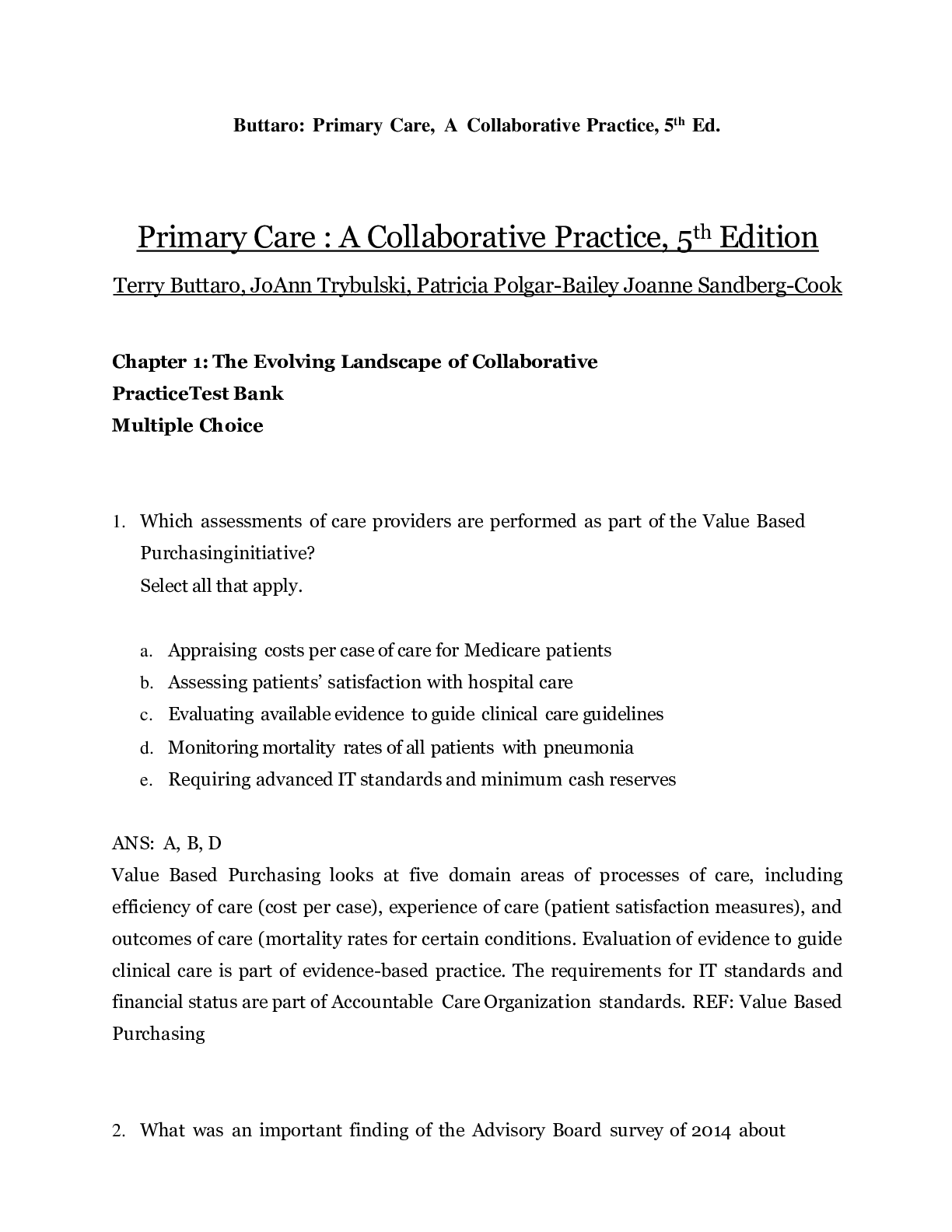


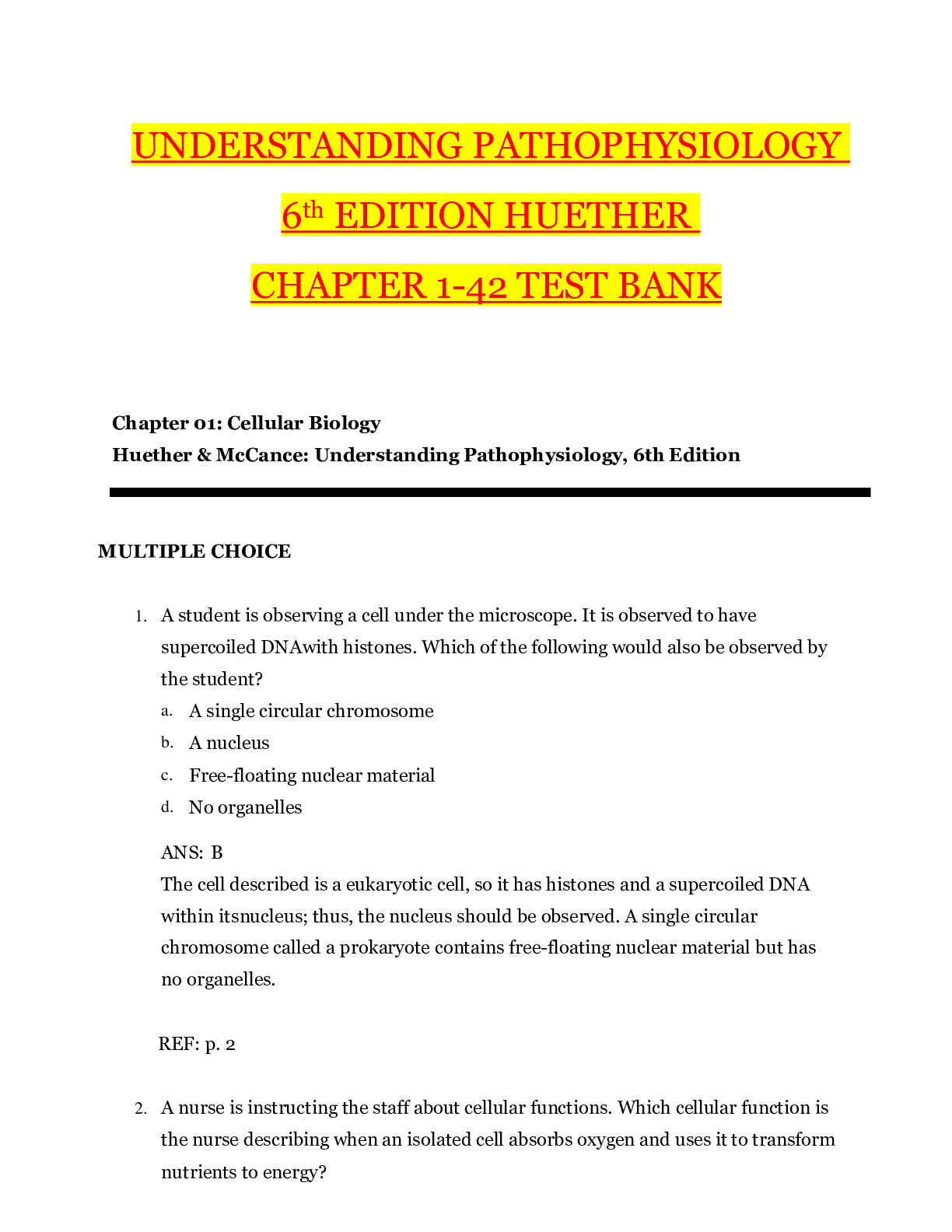

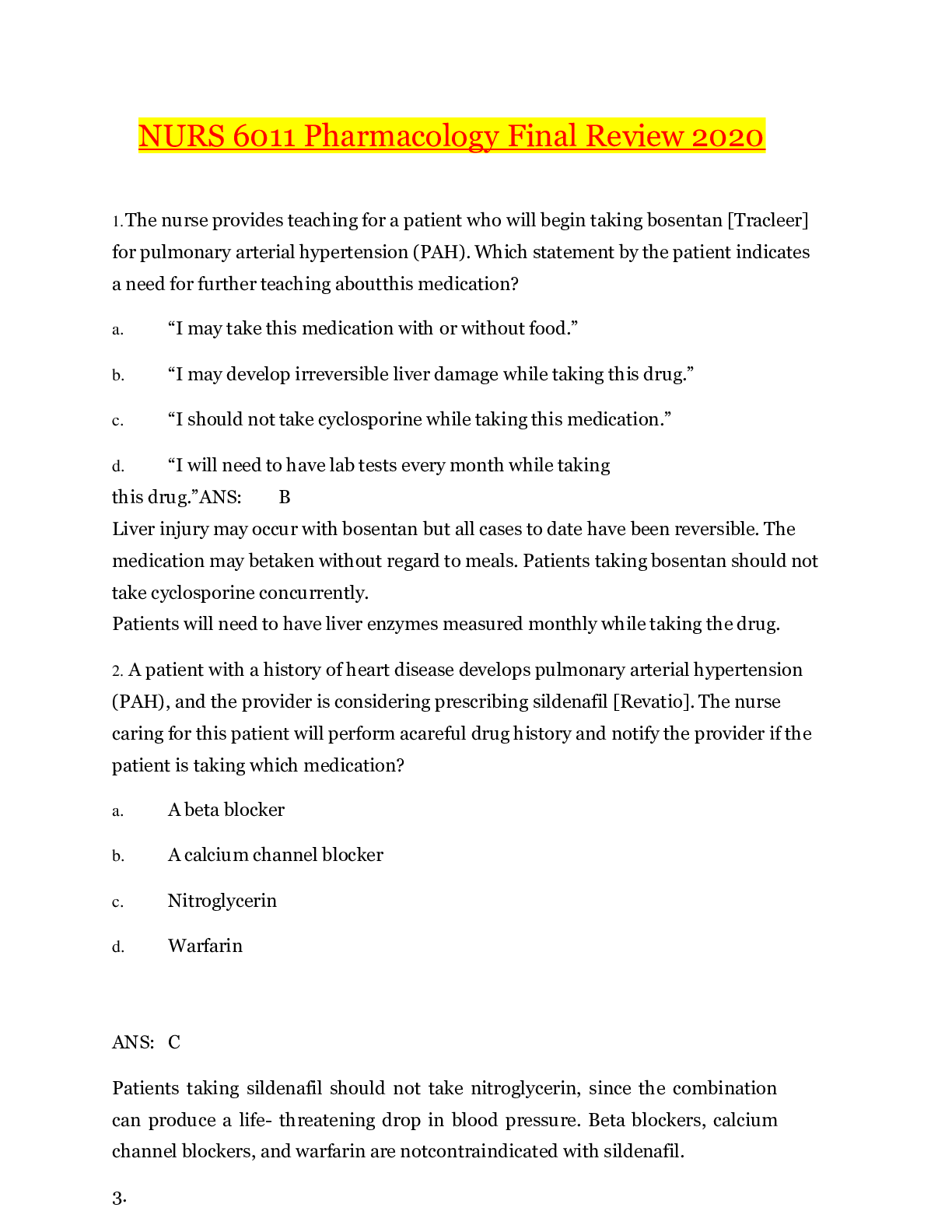
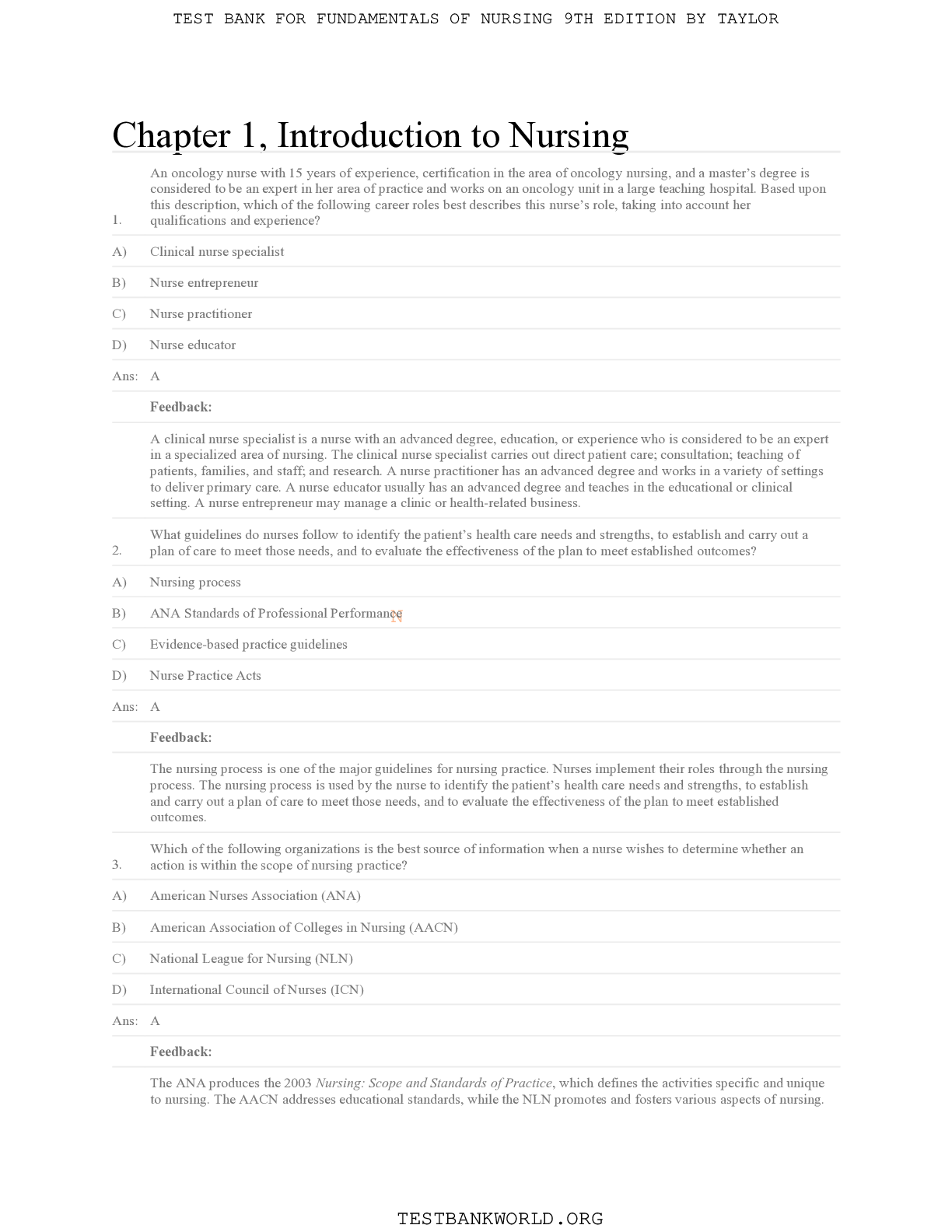
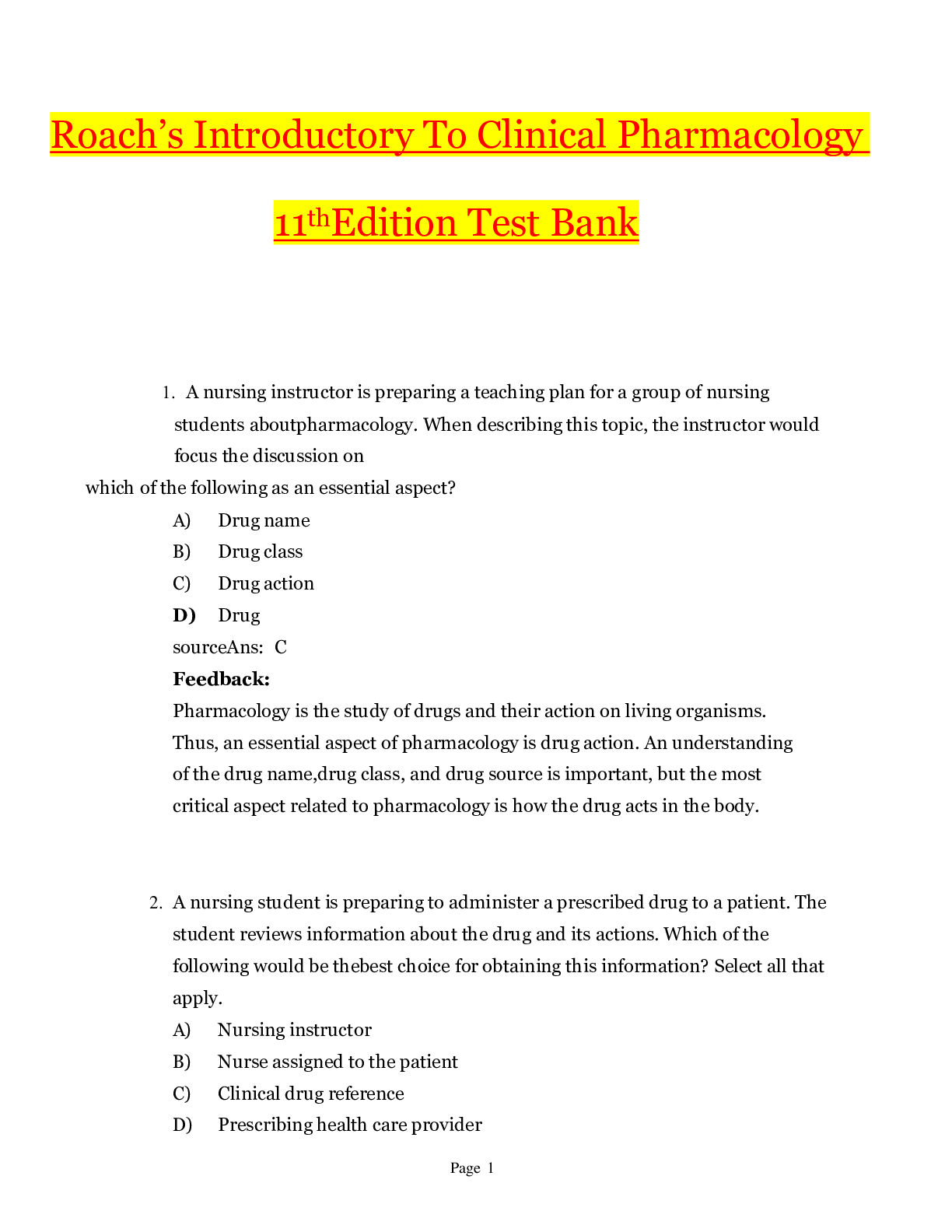

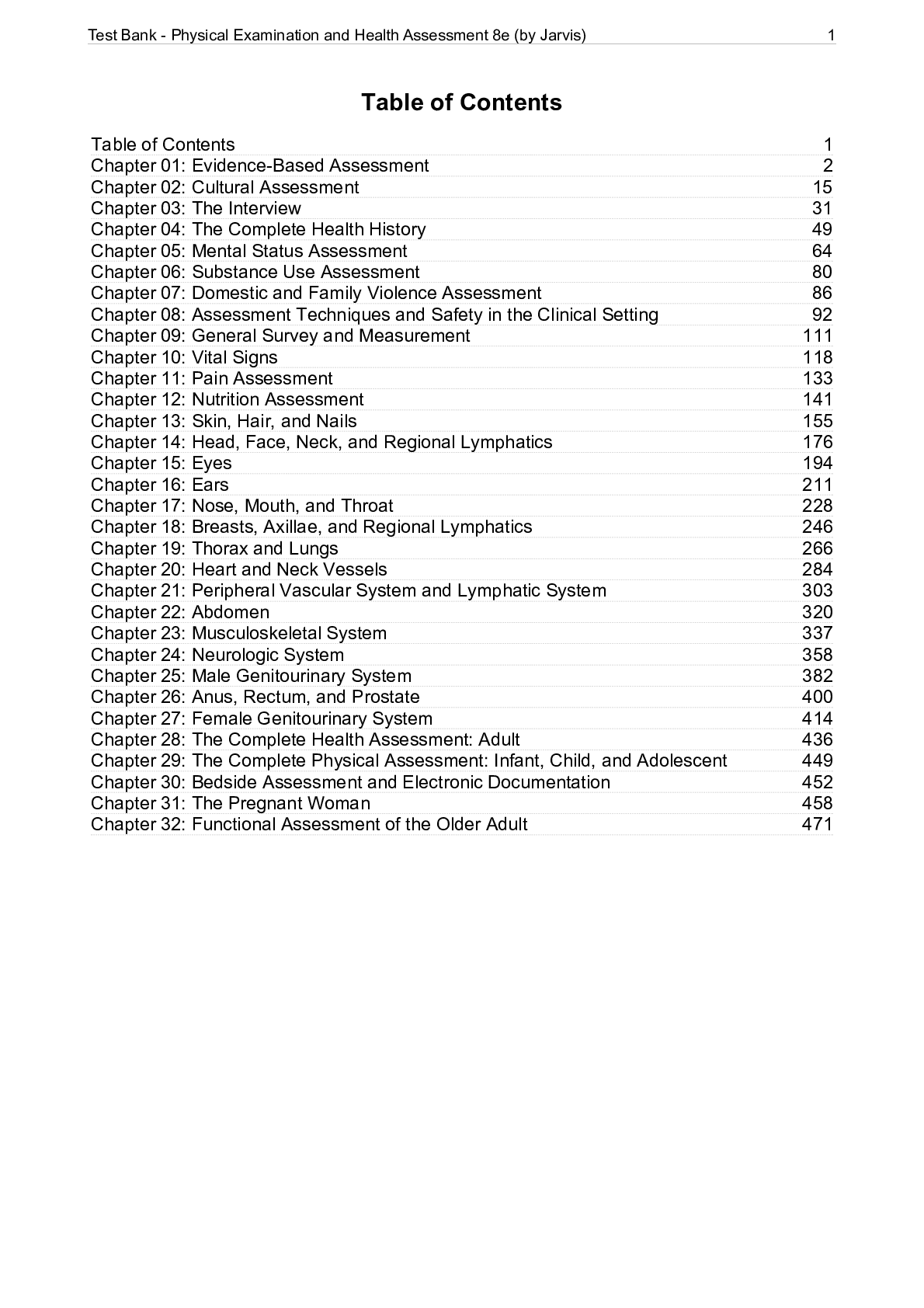

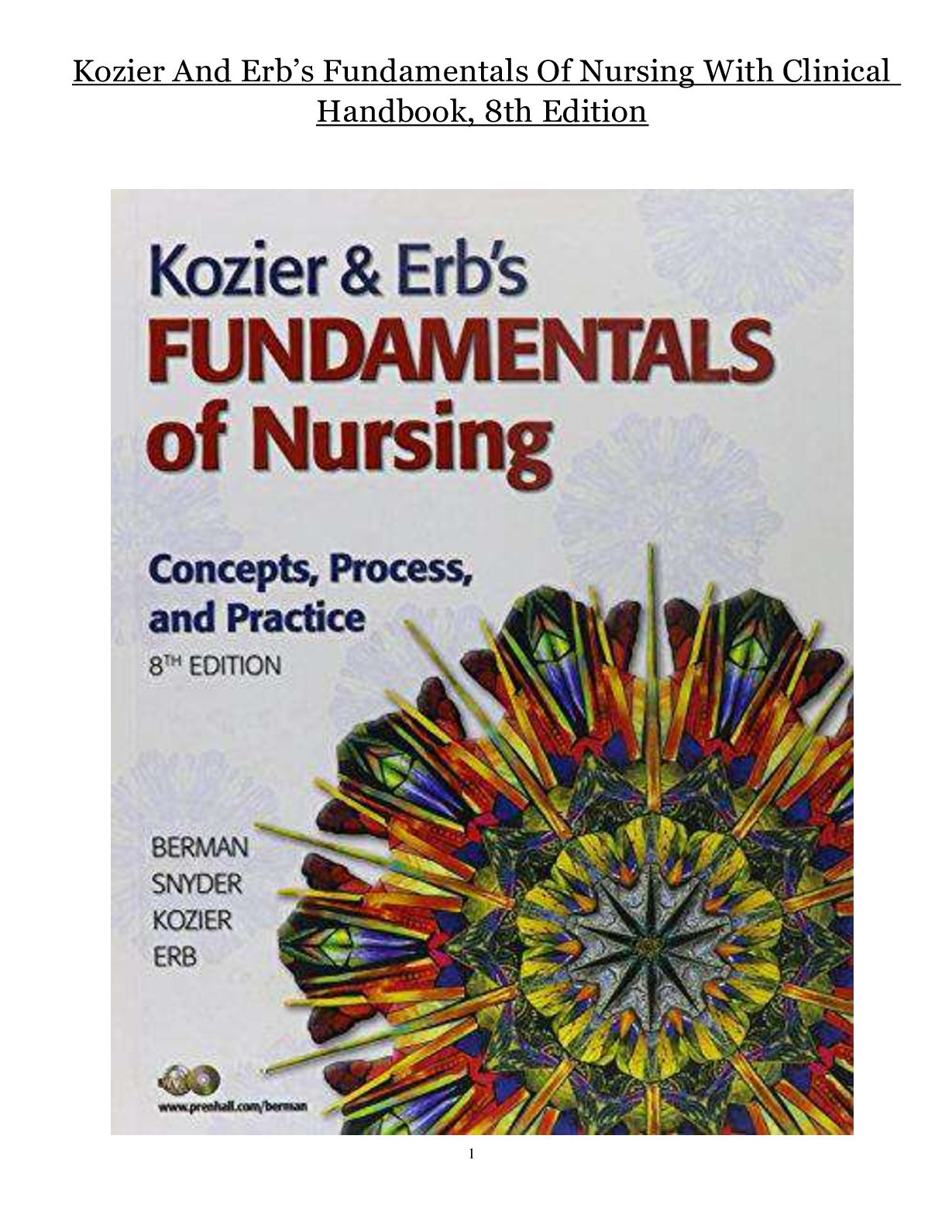
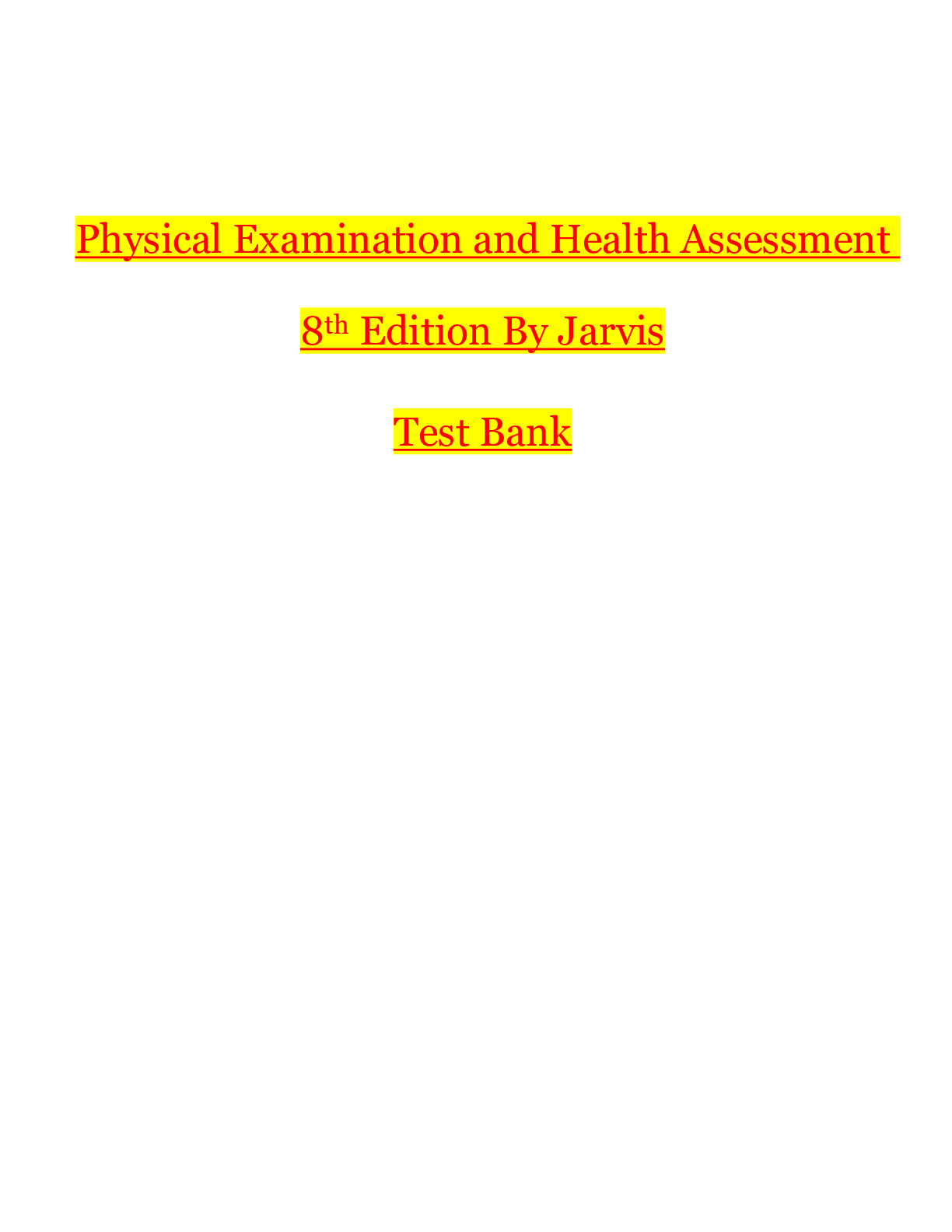




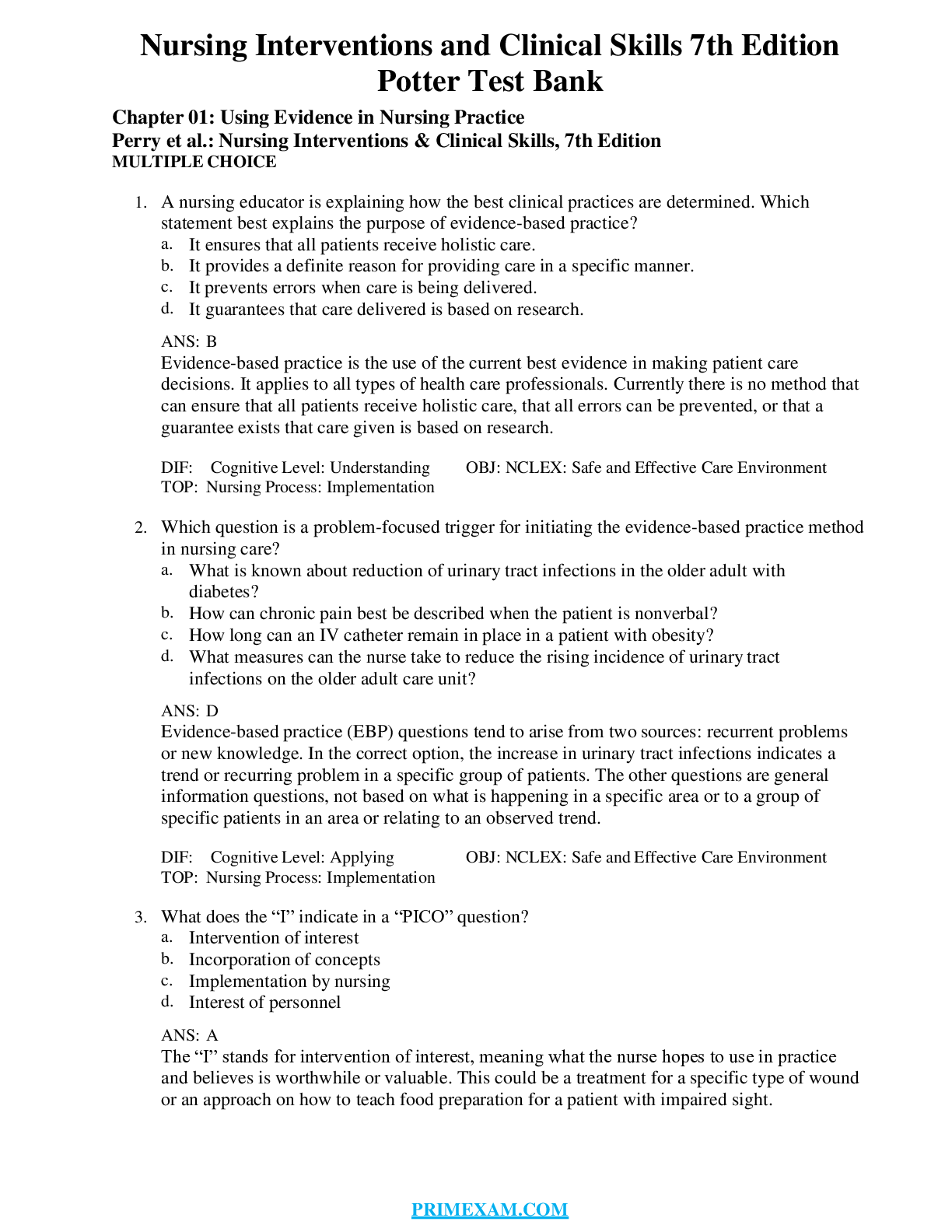
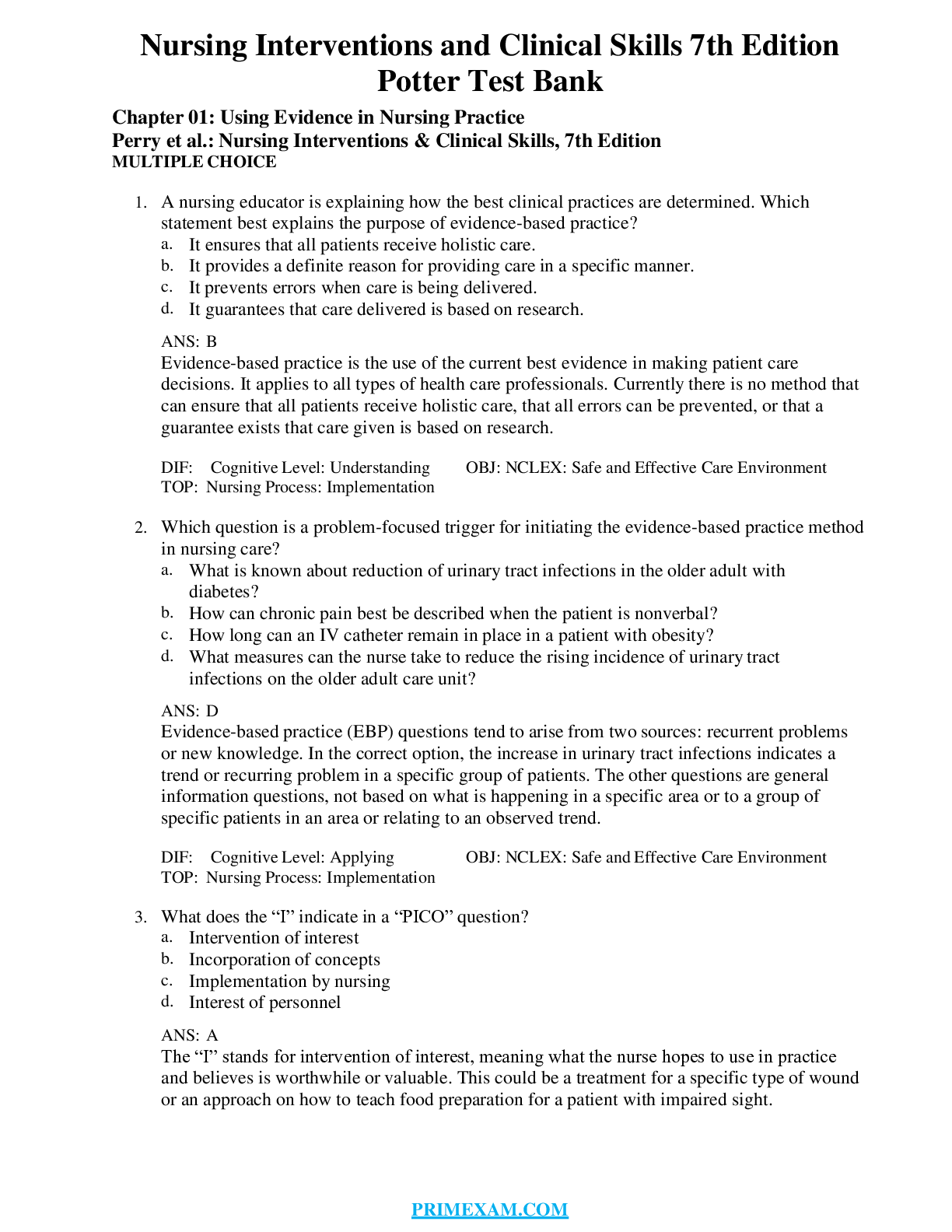

.png)

 Answers With Rationales.png)
.png)
